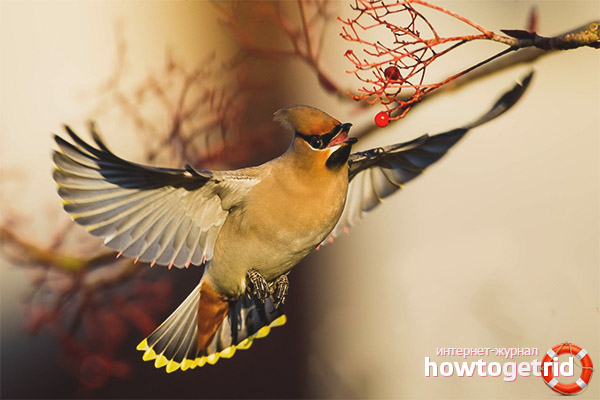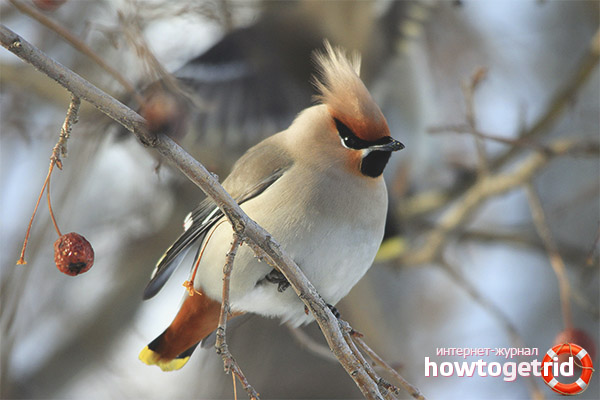The content of the article
The common waxwing is notable for its peculiar structure and bright colors of its feathers. The length of his body reaches 20 centimeters.
Appearance description
The plumage of this bird mainly consists of gray-pink tones with smooth transitions. The head and its neck are usually covered with pink plumage, and the back and stomach of the bird are colored gray. On the eyes, from temple to temple, there is a black spot in shape resembling a mask, which is underlined by a white strip from below.
A crest consisting of elongated pink or brownish feathers is clearly visible on the waxwing head. Under its beak is a darker zone, similar in appearance to a collar. The feather feathers of this bird are painted in dark gray color, they are decorated with mottled blotches consisting of crane, black, yellow and white colors. At the base of her tail is a light gray area, the tail feathers are painted dark gray with yellow ends.
All waxwings have common features that characterize their appearance. They have a fairly short beak, painted black. It serves birds as a multifunctional tool for hunting and labor, and has the ability to perform many complex operations. These birds have small eyes, with an iris of black color. They have not big paws, but they are quite mobile, on each finger there is a small tenacious claw that allows the waxwings to land even on very thin branches that swing under its weight. Under feathers in adults there is a downy layer that prevents birds from freezing on frosty nights.
Birds of this species are distinguished by a bright rather attractive appearance, therefore, few of these birds living in the habitats have not seen these bright eccentrics, who love to make a lot of noise around themselves. They got their name thanks to a special manner of singing, consisting of a combination of high whistling and abrupt cries. Despite the attractiveness of their appearance, with their many-voiced screams, they can drive anyone crazy.
Habitat
The common waxwing is considered a nomad bird because, as a rule, they migrate to the middle lane from the extreme northern regions. In these areas, the winter period is also accompanied by severe frosts, but birds have no problems with food in this strip. Waxwings can be found only in the northern regions of Eurasia and in North America.
Representatives of this species of birds do not make long seasonal flights to the African mainland, India or other places with warm climatic conditions. In the summer, they migrate in the tundra region or a little further to where the forest-tundra begins. By and large, these birds nest in the farthest northern regions of Eurasia, as well as North America.
Ordinary waxwings in winter prefer to settle close to various settlements. The Amur waxwing is distinguished by the fact that it has to make very short migrations; it spends the winter period in the northern regions of China located in the neighborhood. Some individual individuals do not leave their nests at all, despite the severe frosts.
The American waxwing is nesting in the forest regions of northern America and in Canada.In the winter, he makes migrations throughout the United States, up to the southern borders. These birds pose a considerable threat to farms, because, gathering in huge flocks, they can cause significant damage to the crop, most often birds prefer to raid the plantations of blueberries and all kinds of other berries.
Demeanor

During the entire winter season, waxwings prefer to form small flocks, consisting of 2 to 3 dozen individuals, and fly to regions where there is enough food for them. In some areas of the United States, when the time of seasonal migration comes, they are able to form huge flocks of several thousand individuals. This is possible due to the abundance of food on berry plantations, which are located in the southern part of the country.
In the daytime, the presence of these birds is always noticeable - because they make too much noise. Their characteristic whistle can be recognized near many trees, as well as shrubs, where you can profit from berries. At night in winter, when the weather is rampant, waxwings hide in the fluffy branches of spruce trees, where they stray together, waiting for favorable changes. This behavior allows birds to wait out the weather. For migrations to nesting sites, they choose the second half of March.
Offspring
For the device of their nesting birds of this species select areas of taiga light forest. As a rule, they place settlements near water bodies, because small chicks, for accelerated growth, require a large amount of animal food, which is mainly insects. At such times, waxwings try to behave as quietly as possible, a pair of parents, as usual, hiding in the branches of conifers, trying not to betray their nest. Both male and female participate in the construction of the nest.
In order to build a nest, these birds need a tall old spruce, because they build their house at a height of 10 to 13 meters. In their shape, the nests of these birds do not resemble a large neat bowl of elegant shape. As a building material, they use moss and thin stems of dried herbs, for litter of the nest choose fluff, lichens, as well as small plumage or even wool.
As the main tool in the construction of the nest, the waxwing uses its beak, creating not only a reliable place for its masonry, but also giving it elegant forms. Since the nest itself acquires the natural colors of the habitat, it cannot be seen at all in the dense branches of the spruce. Adult birds during this period have to follow all the rules of camouflage, because their chicks can become easy prey for many predators. Squirrels and martens pose a threat from the ground, and ravens and magpies can attack from the sky, less often hawks and even owls.
Building a nest does not take a lot of time from the waxwing, it takes several days for the entire structure. When the construction work is completed and the nest is completely ready, the female begins to lay masonry. In its clutch, as a rule, there are from 5 to 7 eggs that are gray-blue in color with small dots. This coloring makes the eggs almost invisible against the background of the nest.
Only the female is engaged in hatching offspring, and the male at this time takes care of her food. The incubation period in these birds lasts 14 days, both parents take care of the young offspring, alternately bringing the chicks food. With good nutrition, the chicks quickly fledge and are able to carry out their first flights two weeks after birth.
But the first time after departure from the nest, young individuals are not yet able to earn their own food on their own and need guardianship. And only a month later, young growth becomes fully independent and leaves its parents forever.Sexual maturity in waxwings occurs at the age of one year, the length of their life in conditions of will ranges from 10 to 13 years.
Diet

Waxwings are considered very gluttonous birds due to the fact that when an opportunity presents itself, they hammer their stomachs to the dump. The seeds of various berries can not be absorbed by birds, so they are engaged in the distribution of various plant species. Using their well-adapted beak, these birds are able to grab insects on the fly.
The waxwing diet changes with the changing seasons, in warm times it eats various insects such as mosquitoes and mosquito larvae, butterflies, beetles and dragonflies, and also eats some herbs, seeds and mulberry. With the onset of cold weather, these birds have to switch to a plant diet, consisting of various winter berries - bird cherry, juniper, rose hip, lingonberry, viburnum and mountain ash.
Curious facts
In late autumn, when the weather happens, it is changeable and night frosts are replaced by daytime thaws, berries, which serve as the main source of food for waxwings, begin to ferment. As a result of this natural process, the birds are very affected, hopping from such a diet. This phenomenon is very dangerous for them, because, losing their orientation during the flight, they stumble upon various obstacles, trees and even the walls of houses, and sometimes they simply fall into snowdrifts and freeze.
This issue is of concern to various defenders who are taking care of the wildlife, but to date a rational solution to this issue has not been found. Ornithologists cannot come up with a way to feed these birds in the fall.
Video: waxwing (Bombycilla garrulus)










Submit